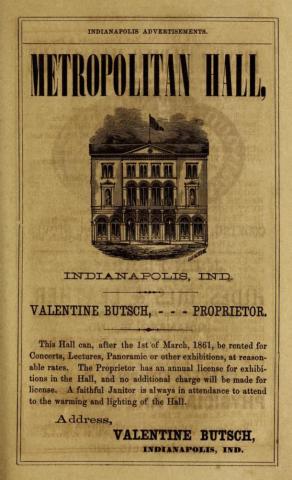For the first few decades of Indianapolis’ existence, regular theatrical entertainment wasn’t on the top of most Hoosiers’ priority lists. When the occasional traveling production would make its way through town, it set up in a tavern, private home, or — after 1850 — the city’s first Masonic hall at the southeast corner of Tennessee and Washington Streets. That was before 1858, when Bavarian-born Valentine Butsch completed Indianapolis’ first building designed for theatrical performances, Metropolitan Hall, on the northeast corner of Tennessee and Washington.
Built at a cost of $60,000, the top two levels of the Metropolitan’s three stories were devoted to its 1200-seat theater, while the street level featured storefronts, a cagey hedging of bets on the part of Butsch. Other theater managers struggled with low attendance and protests by local clergy of the “immoral character” of the theater, so Butsch called his establishment a hall, rather than a theatre. It housed school graduations, club meetings, and ladies’ functions, as well as theatrical productions. In the early 1860s, as Indianapolis became a staging ground for the Civil War, the Metropolitan was packed with soldiers from the area’s Army camps and later kept up Hoosiers’ morale as the war dragged on.
The Metropolitan proved to be extremely profitable for Butsch, but by 1868, he felt it no longer suited Indianapolis’ needs. He then built a 2,500-seat theater, the Academy of Music, on the southeast corner of Illinois and Ohio Streets. Metropolitan Hall was renamed Metropolitan Theatre and became more of a “variety house.”
